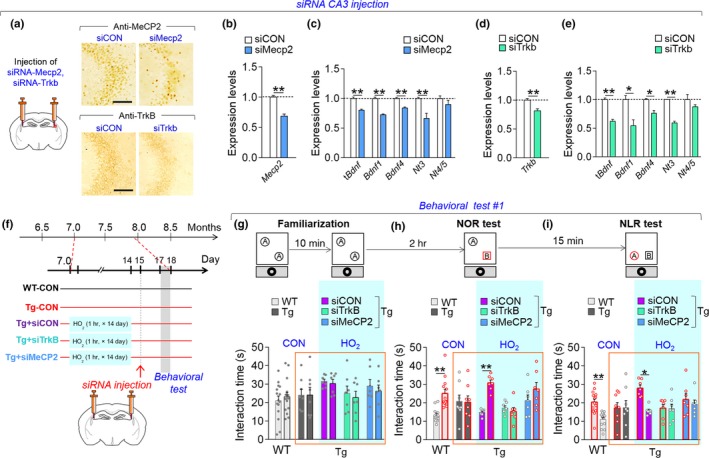Figure 6.

Inhibition of Mecp2 or Trkb in the CA3 subregion blocked the therapeutic effects of HO2. (a–e) Photomicrographs showing siRNA‐mediated knockdown of MeCP2 and TrkB in the CA3 region (a). Expression levels of tBdnf, Bdnf1, Bdnf4, Nt3, Nt4/5, Mecp2 (b) and Trkb (d) in the CA3 of mice injected with siRNA‐MeCP2 (b,c) or siRNA‐TrkB (d,e). Scale bar, 20 μm. (f) Experimental design. Mice were treated with HO2 (100% O2, 2 ATA) from 7 months of age for 1 hr daily for 14 days. The siRNA‐MeCP2 or siRNA‐TrkB was injected into the CA3 subregion of the hippocampus on day 15, and behavioral tests were performed in all mice on day 17. WT‐CON, wild‐type control; Tg‐CON, Tg‐APP/PS1 mice; Tg‐siCON, Tg‐siMeCP2; and Tg‐siTrkB, Tg‐APP/PS1 mice treated with HO2 followed by injection with siRNA‐control, siRNA‐MeCP2, or siRNA‐TrkB, respectively. (g–i) Time spent exploring the two identical objects during the familiarization (g), between a new and an old object 2 hr after familiarization (h, NOR), and between a displaced object and an old object from the previous test (i, NLR). The black circle is a spatial marker posted outside the open field. Blue shaded, mouse groups treated with HO2. Data are presented as mean ± SEM. WT‐CON +siCON, n = 13; Tg‐CON +siCON, n = 8; Tg‐HO2 + siCON, n = 7; Tg‐HO2 + siTrkB, n = 7; Tg‐HO2 + siMeCP2, n = 7 per each group. *p < 0.05; **p < 0.01 (Student's t test and two‐way ANOVA followed by Bonferroni post hoc test)
